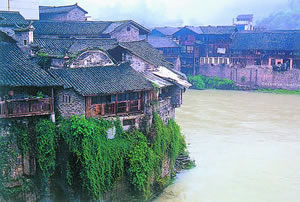 Longtan is an ancient town in the Wuling area. Row upon row of black houses are typical Han nationality structures and most of them are built as siheyuan or compounds with houses around a courtyard.
Longtan is an ancient town in the Wuling area. Row upon row of black houses are typical Han nationality structures and most of them are built as siheyuan or compounds with houses around a courtyard.
Wuling is located at the border of Hunan and Hubei provinces, near Chongqing City. It is famous for its charming scenery, simple way of life, and low traveling expenses.
From Jishou, 160 kilometers away from Zhangjiajie in Hubei Province, you can take a bus along the Tuojiang River into the Wuling Mountains.
The niches in the attics of the houses in Longtan ancient town, however, are of unique Tujia nationality style.
At the edge of the criss-cross network of straight flagstone streets and alleys lies a Catholic church.
The clear water of the Longtan River winds around the town, before running into the Yuanjiang River and then into Dongting Lake.
Because of its closeness to water transport, the town enjoyed a period of prosperity in the late Ming Dynasty (1368-1644) and the early Qing Dynasty (1644-1911), especially during the reign of the Qing Emperor Yongzheng.
At that time, many people immigrated from surrounding provinces, particularly from Jiangxi Province, bringing with them new ideas about doing business. The town went on to become a collection and distribution center for a variety of goods.
Now the whole region covers an area of 258 square kilometers and has a population of more than 50,000, about 10,000 of whom live in the ancient town.
The local government authority has taken steps to protect the town as an important historical site and is seeking to have it declared as one of the worldwide cultural heritage sites of the United Nations Educational, Scientific and Cultural Organization (UNESCO).
Xiche Town
Xiche Town is another place of interest around Wuling. It is named after the Xiche River - "Xiche" comes from a Tujia dialect word meaning "grass river" - because of the luxuriant fragrant grasses along the river's banks.
Xiche Town dates back to the reign of the Emperor Yongzheng.
The architecture of Xiche features both the exquisite Tujia and the traditional Han architectural styles which add to the dynamic beauty of the town.
Fengyu Bridge, also called "Pavilion Bridge" by the locals, is a wood and stone bridge crossing the Xiche River.
Where the bridge and river banks meet are tall diaojiao lou (suspended building) and stores divided by rows of pillars. Long "Beauty Chairs" are spaced along the railings of the bridge for rest and sight-seeing.
Dahe Bridge, a parallel bridge several hundred meters from Fengyu Bridge, and Xiaohe Bridge on the Mengxi River - both modern structures - are good viewing points from which to look over the whole town.
On the other side of Fengyu Bridge is Dongping Street, a 100-metre-long flagstone street where stores dealing in tobacco products, beancurd, traditional foods and hair-dressing do a thriving trade.
Many of the stores have a courtyard at the back and a look through the dusty wooden palings of the doors reveals the street to be almost like a business convention some of the time.
Guandi Temple, located in the middle of the street with a siheyuan, is the only really ancient architecture in the town. The play house opposite the wide courtyard can hold hundreds of people.
Looking back at the town from Dahe Bridge, you can see Dongping Street on the right with seven alleyways stretching to the port with the Mengxi River on the left running under the Xiaohe Bridge to join the Xiche River.
At the corner of Wanzi Street, which faces the river on two sides, a suspension building stands out sharply high up on a rock.
It is well worth taking a walk down Wanzi Street to the riverbank for a good view of Fengyu Bridge, the leg-hanging buildings, the port and the rapidly flowing river.
(Shanghai star November 6, 2002)
|

